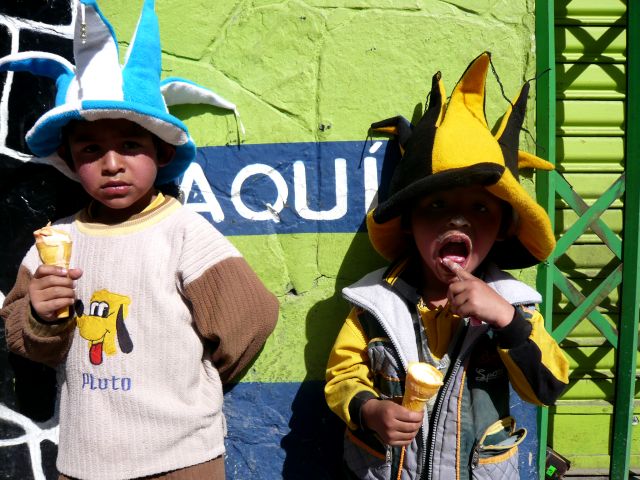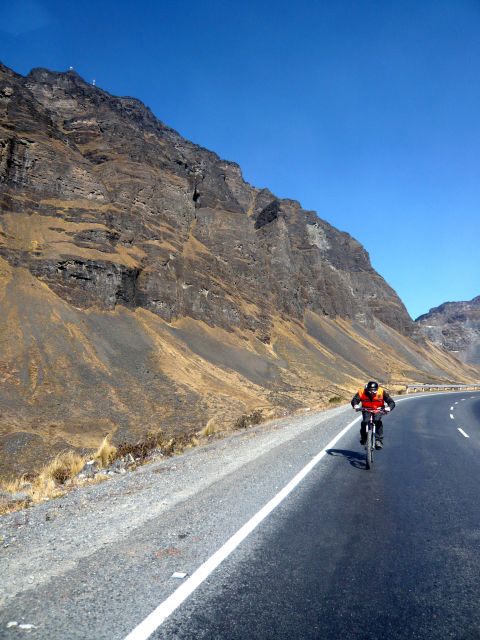Read Robin's story about Biking Bolivia's Death Road on Sympatico MSN! Two and half years later, I retrace my footsteps on the Island of the Sun. Not much has changed. The same little girl is playing on the sacred rock by the Sun Temple. The same man is rowing tourists to the south, weathered lines on his face barely betraying his immense physical effort. The most beautiful sunset in the world can still be found by hiking the Calvario, the hill that overlooks Copacabana. And in La Paz, the air remains choked with diesel fumes and speckled noise. Former eastern-bloc countries have rapidly industrialized in Europe, India and China have become economic powerhouses, and the world has become even more flat in terms of communication and trade, but Bolivia remains as Bolivia was - the poorest country in South America, seemingly barred from progress just like it has been barred from the sea.  Maybe I'm just hallucinating, my oxygen-starved brain crying for drama that isn't there. Last time, I had weeks to acclimatize to the altitude, and when visiting the world's highest capital city (3600m) and highest navigable lake (3800m), your body needs time to prepare for miserly air. This week, my preparation consisted of time in a plane, a short layover in Lima, and watching a man pass out from lack of oxygen on arrival in La Paz's very chaotic airport. Picking my backpack off the conveyer belt resulted in a staccato breath, my heartbeat racing. Thirsting for O2 at altitude literally leaves you high. It was after midnight and La Paz was freezing. Sprawled inside a dry, moon-like valley, half-built houses pockmarked the surrounding mountain, creating a atmosphere of undeniable urban decay. It is a city of only 1.5 million people, although it looks like it could easily accommodate three times that amount. Bright revolutionary graffiti decorates cracked cement walls, modern billboards are few and far between. Driving from the airport, I see stray dogs chewing garbage. The highway feels as if ten thousand pianos once dropped from the sky, and we're still driving over them. I cannot see a single crane, a single sign of urban improvement. Bolivia seems resistant to change. This is not necessarily a bad thing. Maybe I'm just hallucinating, my oxygen-starved brain crying for drama that isn't there. Last time, I had weeks to acclimatize to the altitude, and when visiting the world's highest capital city (3600m) and highest navigable lake (3800m), your body needs time to prepare for miserly air. This week, my preparation consisted of time in a plane, a short layover in Lima, and watching a man pass out from lack of oxygen on arrival in La Paz's very chaotic airport. Picking my backpack off the conveyer belt resulted in a staccato breath, my heartbeat racing. Thirsting for O2 at altitude literally leaves you high. It was after midnight and La Paz was freezing. Sprawled inside a dry, moon-like valley, half-built houses pockmarked the surrounding mountain, creating a atmosphere of undeniable urban decay. It is a city of only 1.5 million people, although it looks like it could easily accommodate three times that amount. Bright revolutionary graffiti decorates cracked cement walls, modern billboards are few and far between. Driving from the airport, I see stray dogs chewing garbage. The highway feels as if ten thousand pianos once dropped from the sky, and we're still driving over them. I cannot see a single crane, a single sign of urban improvement. Bolivia seems resistant to change. This is not necessarily a bad thing.
Before Thomas Friedman wrote the seminal "The World is Flat", he wrote a book called "The Lexus and the Olive Tree". It discusses how modernization battles with cultural habits, how assembly lines of products rubs up against centuries of tradition. We can clearly see the world becoming culturally pasteurized, as multinationals and their invasive brands boil away the richness of local variety. Friedman does not judge whether globalization is for the better or worse. It is a reality of modern life. To see where we're heading, look to the mighty USA. Across an entire continent, every US city has the same stores, the same strip-malls, the same same, hardly different. Travel across the developed world, ditto.  So I appreciate that La Paz conforms to some unwritten theory of urban chaos, where round ladies wearing round bowler hats sell just about anything you can imagine on the streets. Who can afford a cup of Starbucks when it costs more than a week's wages? Who gives a shit about Gap when you're more concerned about goats? I remember well the parts of La Paz that resemble parts of Miami, and certainly there are a few tall buildings (albeit desperately in need of a fresh coat of paint). Small pockets of space serving the tiny upper-class elite, while in Sagarnaga, the backpacker ghetto, it's all Tour Operator and Internet and Hostal and enough Hebrew to make you think you've popped up in the Middle East. Israelis, like Americans, Irish, Argentineans and English, come here because it is cheap. For travellers with US dollars, Bolivia is one of the cheapest countries in the world, easily comparable to India or Laos. Ear-splitting noise, rampant corruption, fake currency, scams, absurd regulations, tap water laced with fecal matter, minimal tourist infrastructure - just a few reasons most tourists skip the country for Peru, who have managed to recognize a foreign gift horse when they see it. Yet travel across the border and you'll find some of the most breathtaking scenery you can imagine, untouched, well beneath the interests of corporate invasion. We're back on the Island of the Sun, staring out over the water at a vista inspired by the gods. The quality of light at 3800m is immaculate, reflecting off the famously blue waters of Lake Titicaca. In the distance, the Royal Mountain range is painted white with snow, floating well over 6000m like a threatening cloud. It is a tundra on the south side of the island, the vegetation barely reaching knee-high. The ruins of a temple that once housed priestesses still remain, a labyrinth of sunken rock. An old man walks past, his two donkeys loaded with wood, a few sheep padding timidly at his heels. Corporations would have to spend a lot of money to duplicate the authenticity of this old world, this theme park of the way things were, are, and probably always will be. "I'm surprised there isn't a hotel right here," says sound guy Zach, holding a makeshift broomstick boompole with a furry microphonic creature at the tip. Hard to take him seriously since his boompole "escaped" during the journey from Vancouver to Colombia. It currently resides in Acapulco in a sordid relationship with a sexy pair of headphones. "Thank God there isn't a hotel right here," I reply, and we head off along the old Incan path, passing pigs, villagers and donkeys, to the rustic village below. So I appreciate that La Paz conforms to some unwritten theory of urban chaos, where round ladies wearing round bowler hats sell just about anything you can imagine on the streets. Who can afford a cup of Starbucks when it costs more than a week's wages? Who gives a shit about Gap when you're more concerned about goats? I remember well the parts of La Paz that resemble parts of Miami, and certainly there are a few tall buildings (albeit desperately in need of a fresh coat of paint). Small pockets of space serving the tiny upper-class elite, while in Sagarnaga, the backpacker ghetto, it's all Tour Operator and Internet and Hostal and enough Hebrew to make you think you've popped up in the Middle East. Israelis, like Americans, Irish, Argentineans and English, come here because it is cheap. For travellers with US dollars, Bolivia is one of the cheapest countries in the world, easily comparable to India or Laos. Ear-splitting noise, rampant corruption, fake currency, scams, absurd regulations, tap water laced with fecal matter, minimal tourist infrastructure - just a few reasons most tourists skip the country for Peru, who have managed to recognize a foreign gift horse when they see it. Yet travel across the border and you'll find some of the most breathtaking scenery you can imagine, untouched, well beneath the interests of corporate invasion. We're back on the Island of the Sun, staring out over the water at a vista inspired by the gods. The quality of light at 3800m is immaculate, reflecting off the famously blue waters of Lake Titicaca. In the distance, the Royal Mountain range is painted white with snow, floating well over 6000m like a threatening cloud. It is a tundra on the south side of the island, the vegetation barely reaching knee-high. The ruins of a temple that once housed priestesses still remain, a labyrinth of sunken rock. An old man walks past, his two donkeys loaded with wood, a few sheep padding timidly at his heels. Corporations would have to spend a lot of money to duplicate the authenticity of this old world, this theme park of the way things were, are, and probably always will be. "I'm surprised there isn't a hotel right here," says sound guy Zach, holding a makeshift broomstick boompole with a furry microphonic creature at the tip. Hard to take him seriously since his boompole "escaped" during the journey from Vancouver to Colombia. It currently resides in Acapulco in a sordid relationship with a sexy pair of headphones. "Thank God there isn't a hotel right here," I reply, and we head off along the old Incan path, passing pigs, villagers and donkeys, to the rustic village below.
A fool might bike the world's most dangerous road once, so what does that make me, riding inches away from a 600m cliff for the second time? Actually, the death road from La Paz to Coroico is safer than it has ever been, thanks to a new highway that has stolen 99% of the traffic. Buses and trucks would frequently flip off the edge of the winding, dirt track, resulting in an average of 150 deaths a year. Today, the 43km of jungle road, and the 22km of asphalt preceding it, sees more traffic from tourists on bicycles. When I was here last, the death toll for tourists was seven. Today it was eleven, the most recent being an Israeli guy who flew off the cliff just a few yards away from the first fatality, an Israeli girl who complained about her brakes from the start, and later slid off the edge. A monument in Hebrew reminds fun-loving tourists of the risks of this adventure Read Robin's full Bolivia Report at his website: moderngonzo.com Read Robin's story about Biking Bolivia's Death Road on Sympatico MSN!
< back to the episode
< back to the list of articles |

